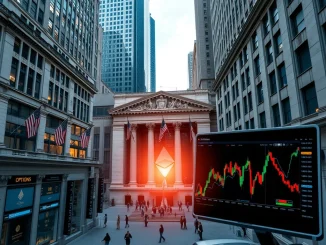
Hold onto your hats, crypto traders! The market just witnessed a seismic wave of liquidations, washing away a staggering $134 million worth of futures contracts in a single hour. If you thought that was dramatic, zoom out to the last 24 hours, and the picture becomes even more intense – a whopping $922 million has been liquidated across major cryptocurrency exchanges. This massive sell-off has sent ripples of concern through the crypto sphere, leaving many wondering: what exactly triggered this sudden market upheaval, and what does it mean for the future of digital assets?
Decoding the Crypto Liquidation Frenzy: What Happened?
Futures liquidation events, especially of this magnitude, are rarely random. They are often triggered by a confluence of factors that create a domino effect in the highly leveraged world of cryptocurrency trading. Here’s a breakdown of what typically leads to such dramatic market corrections:
- Sudden Price Drops: The most common trigger is a sharp and unexpected drop in the price of cryptocurrencies like Bitcoin and Ethereum. When prices fall rapidly, traders using leverage can find themselves on the wrong side of their bets, leading to margin calls and, ultimately, liquidations.
- Market Volatility Spike: Increased crypto market volatility can exacerbate liquidation events. Volatile markets create uncertainty, and even small price fluctuations can trigger liquidations for over-leveraged positions.
- Whale Activity: Large traders, often referred to as “whales,” can significantly influence market movements. A large sell order from a whale can initiate a cascade of selling pressure, leading to price drops and subsequent futures liquidation events.
- External Economic Factors: Broader economic news, such as inflation reports, interest rate hikes, or regulatory announcements, can impact the crypto market. Negative news often leads to market downturns and increased liquidations.
- Cascading Liquidations: Once liquidations begin, they can create a snowball effect. As prices fall due to initial liquidations, more positions get liquidated, further driving down prices and triggering even more liquidations. This creates a vicious cycle of selling pressure.
Why $922 Million in Liquidations is a Big Deal?
The sheer scale of $922 million in futures liquidated in a single day underscores the inherent risks and volatility associated with cryptocurrency trading, particularly when leverage is involved. Here’s why this number is significant:
- Market Instability: Large liquidations indicate underlying market instability and fear. They highlight how quickly sentiment can shift and how vulnerable the crypto market can be to sudden corrections.
- Trader Losses: Millions of dollars liquidated translate to significant financial losses for individual traders. Many traders using high leverage can see their entire positions wiped out in such events.
- Potential for Contagion: Massive liquidations can sometimes trigger wider market contagion. Fear and uncertainty can spread, leading to further selling pressure across the crypto ecosystem, impacting even those who were not directly involved in futures trading.
- Leverage Risks Highlighted: These events serve as a stark reminder of the dangers of excessive leverage in crypto trading. While leverage can amplify gains, it can also magnify losses exponentially, leading to devastating outcomes during market downturns.
Bitcoin Futures Dominate Liquidations
While the data encompasses various cryptocurrencies, Bitcoin futures often represent a significant portion of liquidation volumes. Bitcoin, being the flagship cryptocurrency, typically sees the highest trading volume and open interest in futures markets. Consequently, price swings in Bitcoin tend to have a disproportionate impact on the overall liquidation figures. Ethereum futures also contribute significantly, but Bitcoin usually leads the pack in liquidation events due to its market dominance.
 A visual representation of futures liquidation volume across major exchanges.
A visual representation of futures liquidation volume across major exchanges.
Navigating Crypto Market Volatility: Tips for Traders
Crypto market volatility is a double-edged sword. It presents opportunities for profit but also carries substantial risks. Here are some actionable insights to help traders navigate these turbulent waters:
- Manage Leverage Wisely: Avoid excessive leverage, especially if you are a new or less experienced trader. Start with lower leverage and gradually increase as you gain experience and understanding of market dynamics.
- Use Stop-Loss Orders: Implement stop-loss orders to limit potential losses. A stop-loss order automatically closes your position if the price reaches a predetermined level, helping to protect your capital during sharp market downturns.
- Diversify Your Portfolio: Don’t put all your eggs in one basket. Diversify your crypto portfolio across different assets to mitigate risk. If one asset experiences a significant drop, the impact on your overall portfolio will be less severe.
- Stay Informed and Analyze Market Trends: Keep abreast of market news, analyze price charts, and understand technical indicators. Informed trading decisions are crucial for navigating volatile markets.
- Understand Risk Tolerance: Be realistic about your risk tolerance. Only invest what you can afford to lose, especially in highly volatile markets like crypto.
- Consider Hedging Strategies: Explore hedging strategies to protect your portfolio against potential downturns. Hedging involves taking positions that offset potential losses in your primary holdings.
The Road Ahead: Will Crypto Markets Recover?
The crypto market is known for its resilience and cyclical nature. While massive exchange liquidation events like this can cause short-term pain and uncertainty, they are often followed by periods of recovery and renewed growth. The long-term trajectory of the crypto market remains tied to factors such as technological advancements, adoption rates, regulatory clarity, and broader economic conditions.
While the recent futures liquidation event is a stark reminder of the market’s inherent volatility, it also presents an opportunity for traders to reassess their strategies, manage risk more effectively, and prepare for future market fluctuations. The crypto journey is rarely a smooth ride, but for those who navigate it with caution and knowledge, the potential rewards can be significant.



